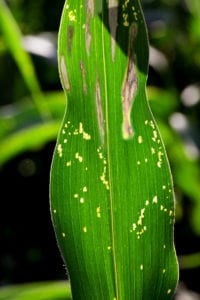Gray Leaf Spot

Gray leaf spot is one of the most yield-limiting diseases in corn.
Gray leaf spot leads to leaf tissue loss, a decrease in plant sugars and decreased grain production. It is considered the world’s most yield-limiting disease in corn, causing yield losses from 5-to-40 percent. All corn hybrids have some susceptibility to this disease, which is caused by the fungus Cercospora zeae-maydis.
Gray leaf spot infection occurs when relative humidity is more than 90 percent and the leaf surface remains wet for more than 11 hours. Shortly after tasseling occurs, orange-red lesions with narrow yellow halos appear. As lesions mature, they appear tan or brown in color and rectangular in shape. The release of gray fungal spores in mature lesions give the disease its name. Lesions range from 1/2 inch to four inches long and are vein-limited, giving them a straight-edge appearance.
Fungicides are recommended when susceptible hybrids are planted in fields with a history of gray leaf spot. Apply fungicides early in the season before significant leaf damage occurs.
Your AgVenture Yield Specialist can help you develop a fungicide plan that will be most effective for your fields.
Anthracnose Leaf Blight

Anthracnose leaf blight lesions can enlarge to 5-6 inches and can blight the entire leaf.
Anthracnose leaf blight, or Colletotrichum graminicola, favors high temperatures and prolonged wet or humid weather. It is spread by wind and splashing rain.
Symptoms begin on lower corn leaves early in the growing season and develop on the upper leaves late in the season. The disease presents as water-soaked, oval lesions with tan centers and reddish-brown borders.
Lesions can enlarge up to six inches long and may join to blight in the entire leaf, causing it to die late in the growing season. Dark, raised spots and spines that protrude from the leaf can appear on dead tissue. Yield reductions occur with significant leaf death within the first six weeks after tasseling.